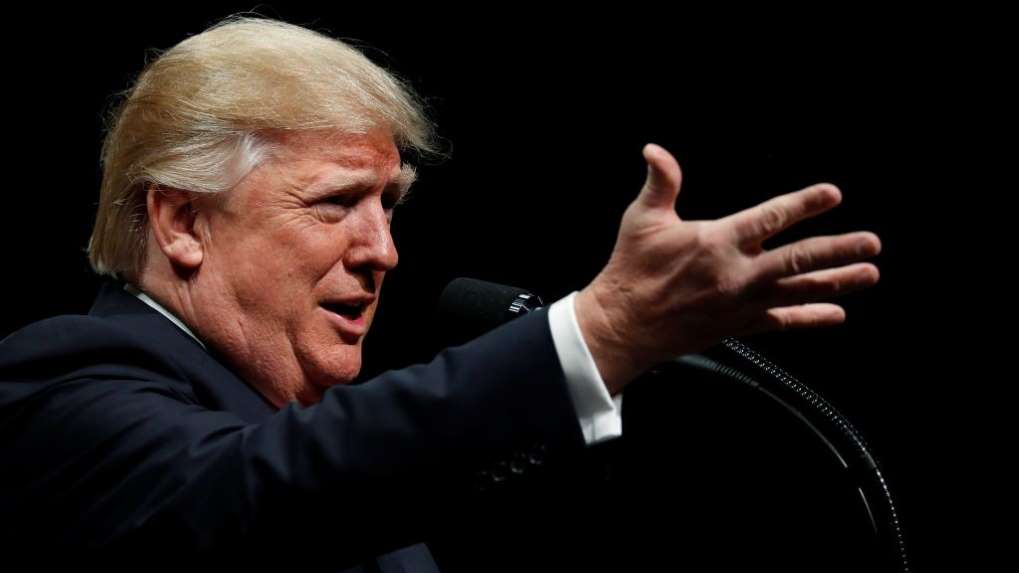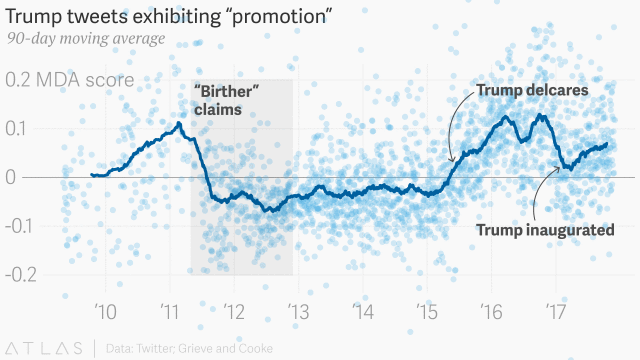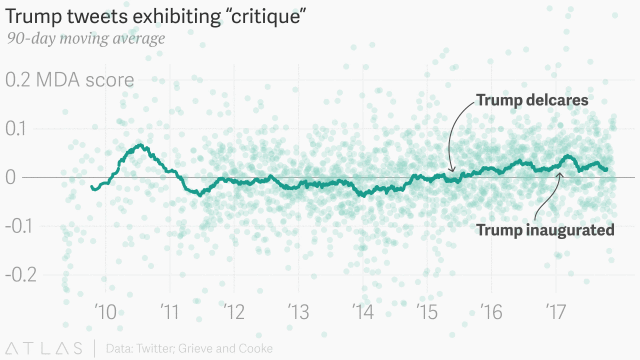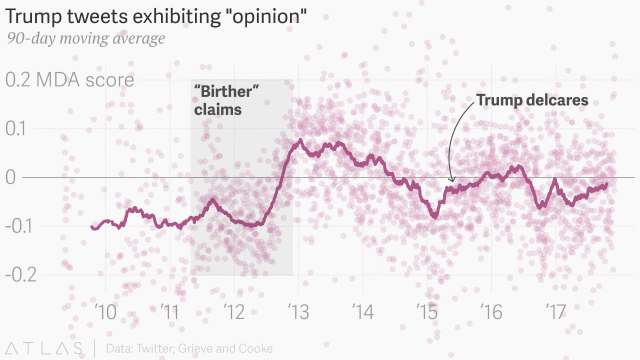December 17, 2017

U.S. President Donald Trump delivers remarks at a graduation ceremony at the FBI Academy on the grounds of Marine Corps Base Quantico in Quantico, Virginia, U.S. December 15, 2017.
Donald Trump’s first tweet—from the bygone era of 2009 America—was a simple tweet, for simpler times.
December 17, 2017

U.S. President Donald Trump delivers remarks at a graduation ceremony at the FBI Academy on the grounds of Marine Corps Base Quantico in Quantico, Virginia, U.S. December 15, 2017.
Donald Trump’s first tweet—from the bygone era of 2009 America—was a simple tweet, for simpler times.
Be sure to tune in and watch Donald Trump on Late Night with David Letterman as he presents the Top Ten List tonight!
— Donald J. Trump (@realDonaldTrump) May 4, 2009
But more recently, things have heated up. Last week, Trump called the New York Times “Wrong!” and CNN anchor Don Lemon the “dumbest man on television!” all in a single tweet.
Has Trump’s use of his favorite platform for disseminating information changed? Two linguists threw eight years worth of tweets—36,000— into a statistical model to find out. Their analysis reveals intriguing changes in style and tone, depending on the political situation.
The study (more details on the methodology below) uses a linguistic trick called “multidimensional analysis.” This can find the characteristics that account for biggest differences within Trump’s feed. The linguists, Jack Grieve and Isobelle Clarke at the University of Birmingham in the UK, then looked at tweets that scored highest on each characteristic, or “dimension,” and interpreted each as a kind of style or tone.
Let’s look at a couple examples. The analysis revealed a dimension of Trump’s tweets visible in these two: “promotion”.
Governor @Mike_Pence and I will be in Cleveland, Ohio tomorrow night at 7pm – join us! #MAGA
Tickets: https://t.co/hre7FofPxQpic.twitter.com/5lhrb7POGl
— Donald J. Trump (@realDonaldTrump) October 22, 2016
Join me live- now in Las Vegas, Nevada! We will MAKE AMERICA SAFE & GREAT AGAIN! #VoteTrumpNV#NevadaCaucushttps://t.co/IW9s9noxDT
— Donald J. Trump (@realDonaldTrump) February 23, 2016
So tweets that got higher scores in this dimension are more likely be self-promotional.
The tweet below scored very highly on another dimension, which they interpreted to mean “critique.”
N.Y. City is paying FORTY MILLION DOLLARS to five men that many think are guilty as hell. So many facts – should have been trial. Politics!
— Donald J. Trump (@realDonaldTrump) June 22, 2014
By looking at the linguistic features and the tweets that scored highest on each dimension, researchers identified five characteristics that describe Trump’s tweeting: advice, critique, opinion, prediction, and promotion.
With that in hand, they can compare how tweets have shifted along these dimensions over time. That shows, for example, that Trump’s “promotional” tweets skyrocket leading up to and after his declaration of intent to run for president:

His tweets have also become more “critical” since that same point.

The “opinion” dimension also follows an interesting trajectory that points to the origins of Trump’s presence in US politics. The first year or two of Trump tweets is pretty bland—announcements of TV appearances, anodyne business advice, stuff about The Apprentice. Then in 2011, after Trump scored a political victory by pressuring Barack Obama to release his birth certificate, the tweets turn political and opinionated. Miss USA promos give way to “the Debt Limit cannot be raised until Obama spending is contained” and “Obama is addicted to spending America into insolvency.”
According to the analysis, the level of opinion continues to rise until Obama’s second inauguration in 2013. It then ticks back up in the run-up to Trump’s selection as the Republican nominee in 2016.

What does all this mean? “We see these changes in language use on the account, in the style of the account, around important dates,” says Grieve. “That arguably shows how Trump, and his team presumably, shifted the style of these tweets depending on their political goals and how they reacted to certain events.”
The analysis reveals that the “birther” campaign, for example, appears to have shown Trump for the first time the power of expressing his controversial opinions on the platform that has become such a central part of his presidency.
A bit more on “multidimensional analysis,” for the curious. The goal of this method is to model stylistic variation in a database of text. To do that, a computer program takes a large amount of text data and figures out which of dozens of grammatical structures—like types of verbs, questions, superlatives, and plenty more—are most common in each of the individual texts dataset. Finally, the analysis identifies patterns across groups of grammatical forms, which taken together can group the texts into different “dimensions.” Looking at the dimensions that account for the biggest variation in grammar within the dataset can explain the differences in style over time.
Grieve and Cooke aim to use this model in the future to try to identify the authorship of tweets by Trump and others—when does he write his own, and when are they ghostwritten? Linguists got forensic a couple weeks ago when a tweet that came from Trump’s account seemed to implicate him in obstruction of justice, only to have his lawyer claim that he, not Trump, had written it.
This research finds that that particular tweet was atypical of the timeline on the whole. An algorithm developed by The Atlantic gave this particular tweet a 38% chance of having been written by Trump. That could help separate out Trump’s personal opinions from more official matters of administration policy.
The model might also help pin down what exactly makes Trump’s writing style on Twitter so distinctive. It’s not just the exclamation points!
Courtesy/Source: Quartz















































































































